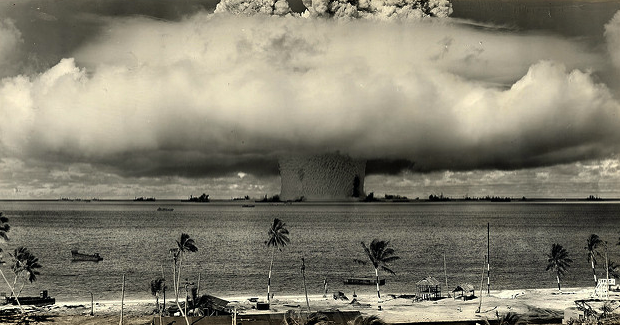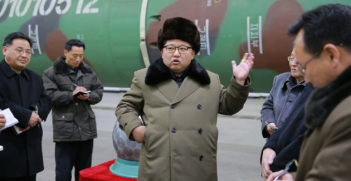Nuclear Weapons Could and Should Disappear

Last week delegations from around the world met in Geneva to discuss the elimination of nuclear weapons once and for all. A majority of states have declared that they want this to happen and for the process to begin in 2017. In this context, and at this point in time, we need to be reminded of how devastating these weapons are.
We’re at a moment that’s been 71 years in the making; the turning point of a campaign that began as soon as the horrors of Hiroshima and Nagasaki were revealed. Last week in Geneva, under the aegis of the United Nations, states finalised discussions on how best to rid the world of more than 15,000 nuclear weapons.
Following a resolution at the United Nations General Assembly last year, an Open Ended Working Group (OEWG) was formed to explore issues relating to nuclear weapons and disarmament. The discussions of the OEWG concluded on Friday 19 August in a session that found a majority of states want negotiations for a nuclear weapons ban treaty to start next year. This will be the recommendation going forward to the UN General Assembly in October, which is a significant turning point in history.
What we have known for some time is that nuclear weapons are far more than a threat to a single city or country. Their use will have catastrophic consequences for the whole world.
Here are the facts; not to scare, but to illuminate.
The Little Boy bomb dropped on Hiroshima exploded with the energy of 12,000-18,000 tonnes of TNT. Just one of today’s weapons has the equivalent force of close to one million tons of dynamite—that’s half the destructive power of all bombs dropped by the allies in Europe during World War II. Putting it in perspective; a one-megatonne warhead is equivalent to a 482 kilometre-long train packed full with dynamite.
According to Charles Derber, professor of sociology at Boston College, if a one-megatonne nuclear weapon was dropped on a major city such as New York, some 2.25 million people would die, one million of them in 11 seconds. The bomb would cause a firestorm 100 times the size of Sydney’s central business district.
But what happens next is where things become truly catastrophic. A nuclear war would set off a chain of disasters. The radiation will ravage the environment for decades to come. You’ve probably heard cockroaches would be the only survivors after a nuclear blast—but even they would have residual injuries such as blindness.
A Rutgers University study showed that dense smoke from a nuclear war would block sunlight and plunge much of the world into darkness. Without adequate sunlight, there would be overwhelming crop failure, leading to mass starvation in the furthest corners of the globe.
Humanitarian relief is Red Cross’ core business. Yet, like all other humanitarian agencies, we would be effectively powerless to help. Radiation would make the blast site and surrounding areas inaccessible and lead to debilitating long-term health problems. Hospitals would be destroyed and no usable infrastructure would remain. And no public appeals could possibly ever meet the needs of the millions—and eventually billions—affected.
Right now, there are more than 15,000 weapons capable of this kind of damage, of which 1,800 are on high-alert status, ready to be launched in minutes. Some of these are 10 or even 20 megatonnes, dozens of times bigger than the bomb that flattened Hiroshima.
These bombs are increasingly subject to risks such as an accidental or unauthorised detonation which may be caused by cyberattack, systems, and radar or satellite errors. Risks also exist through escalation or intent.
Compounding the fragile security climate is the threat of human error. Recent research highlights how a nuclear conflict could begin with something as simple as one nation misinterpreting an event such as a training exercise, a weather phenomenon, or technical malfunction as a nuclear attack or provocation.
That is why the outcome of these meetings in Geneva is pivotal. After decades of the Cold War and all too little progress under the Nuclear Non-Proliferation Treaty, the world appears poised to change the status quo on nuclear weapons. The vast majority of states have now expressed their support for an international, legally-binding instrument that would prohibit and eventually eliminate nuclear weapons. Such a process has already led to a global ban on landmines, chemical and biological weapons—it’s time to do the same for the only weapon of mass destruction that is not yet illegal.
The United Nations OEWG on nuclear disarmament has given world leaders a tremendous opportunity to rid the world of these weapons once and for all. At the UN General Assembly in October, we must see a resolution recommending immediate negotiations to achieve a binding global nuclear weapon ban treaty.
At this time 71 years ago, the world was facing the reality of two Japanese cities destroyed by atomic bombs. Nuclear weapons are an unacceptable risk to humanity and they must be placed in a bygone era. It’s time to meet our global responsibility to ensure such atrocities never happen again.
Dr Phoebe Wynn-Pope is director of international humanitarian law and movement relations, Australian Red Cross. Phoebe holds a PhD in international law focusing on the role of the international community when confronting war crimes, crimes against humanity and genocide.
This article is published under a Creative Commons Licence and may be republished with attribution.





